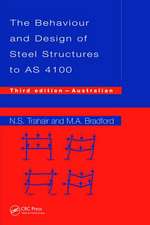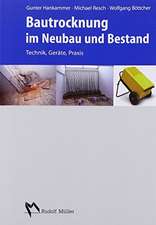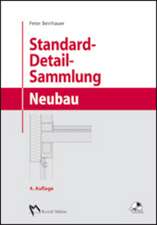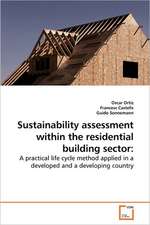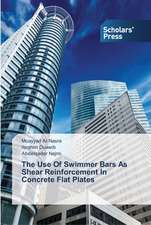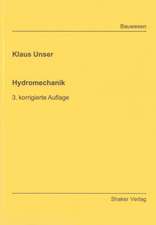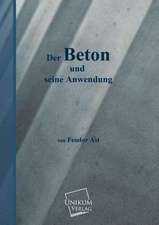Seawater in Concrete Mix
Autor Hidenori Hamada, Nobuaki Otsuki, Takahiro Nishidaen Limba Engleză Paperback – 29 ian 2024
According to the worldwide standard for reinforced concrete (RC), freshwater is typically used in concrete mixing rather than seawater. Yet a potential exists for the extensive use of seawater in concrete, especially with the addition of ground granulated blast-furnace slag, fly ash, or other mineral admixtures. The recent trend toward performance-based design makes this alternative more viable.
The text is ideal for graduate students, researchers, concrete engineers, and all civil engineers who deal with concrete for infrastructure.
Hidenori Hamada is Professor of Kyushu University, Japan.
Nobuaki Otsuki is Professor Emeritus of Tokyo Institute of Technology and was Chairman of the JCI Technical Committee on the use of seawater in concrete.
Takahiro Nishida is Senior Researcher of the Japanese National Institute of Maritime, Port and Aviation Technology.
| Toate formatele și edițiile | Preț | Express |
|---|---|---|
| Paperback (1) | 137.06 lei 6-8 săpt. | |
| CRC Press – 29 ian 2024 | 137.06 lei 6-8 săpt. | |
| Hardback (1) | 463.62 lei 6-8 săpt. | |
| CRC Press – 12 oct 2021 | 463.62 lei 6-8 săpt. |
Preț: 137.06 lei
Preț vechi: 167.69 lei
-18% Nou
Puncte Express: 206
Preț estimativ în valută:
26.23€ • 27.46$ • 21.70£
26.23€ • 27.46$ • 21.70£
Carte tipărită la comandă
Livrare economică 05-19 aprilie
Preluare comenzi: 021 569.72.76
Specificații
ISBN-13: 9781032046693
ISBN-10: 1032046694
Pagini: 144
Ilustrații: 76
Dimensiuni: 138 x 216 mm
Greutate: 0.19 kg
Ediția:1
Editura: CRC Press
Colecția CRC Press
ISBN-10: 1032046694
Pagini: 144
Ilustrații: 76
Dimensiuni: 138 x 216 mm
Greutate: 0.19 kg
Ediția:1
Editura: CRC Press
Colecția CRC Press
Public țintă
Postgraduate and ProfessionalNotă biografică
Hidenori Hamada is Professor of Kyushu University, Japan, since 2009. His has previously worked as a Senior Research Engineer, Head of Materials Division, and a member of Port and Airport Research Institute, Yokosuka, Japan. His research topics include durability of RC and PC structures under marine conditions, life extension technology of severely deteriorated RC and PC structures, and eco-friendly concrete material development such as seawater utilization in concrete production.
Nobuaki Otsuki is Professor Emeritus of Tokyo Institute of Technology, Japan. He has worked as a Senior Research Engineer and Head of Materials Division at Port and Airport Research Institute, Yokosuka, Japan. His research include are durability of RC and PC structures under marine conditions, life extension technology of severely deteriorated RC and PC structures, and eco-friendly concrete material development such as seawater utilization in concrete production
Takahiro Nishida is Senior Researcher of the Japanese National Institute of Maritime, Port and Aviation Technology, and Port and Airport Research Institute, Japan. He has worked for several research institutes, including port and airport, electric power industry, and highway. He has taught construction material at Tokyo Institute of Technology and Kyoto University. His research interests include durability and maintenance of civil engineering structures.
Nobuaki Otsuki is Professor Emeritus of Tokyo Institute of Technology, Japan. He has worked as a Senior Research Engineer and Head of Materials Division at Port and Airport Research Institute, Yokosuka, Japan. His research include are durability of RC and PC structures under marine conditions, life extension technology of severely deteriorated RC and PC structures, and eco-friendly concrete material development such as seawater utilization in concrete production
Takahiro Nishida is Senior Researcher of the Japanese National Institute of Maritime, Port and Aviation Technology, and Port and Airport Research Institute, Japan. He has worked for several research institutes, including port and airport, electric power industry, and highway. He has taught construction material at Tokyo Institute of Technology and Kyoto University. His research interests include durability and maintenance of civil engineering structures.
Cuprins
1 Introduction PART I Research and Technology 2 Engineering Properties of Seawater Concrete (with OPC and BFS/FA) 3 Special Techniques for Seawater Concrete PART II Actual Constructions 4 Japanese Experience with Seawater Concrete 5 European Experience with Seawater Concrete 6 Summary and Future Scope
Descriere
Many parts of the world will soon suffer from a shortage of freshwater, so effective use of seawater in concrete production could therefore become a crucial technology. This text provides a detailed overview of the fundamental knowledge of concrete engineering that is essential for the usage of seawater-mixed concrete.

